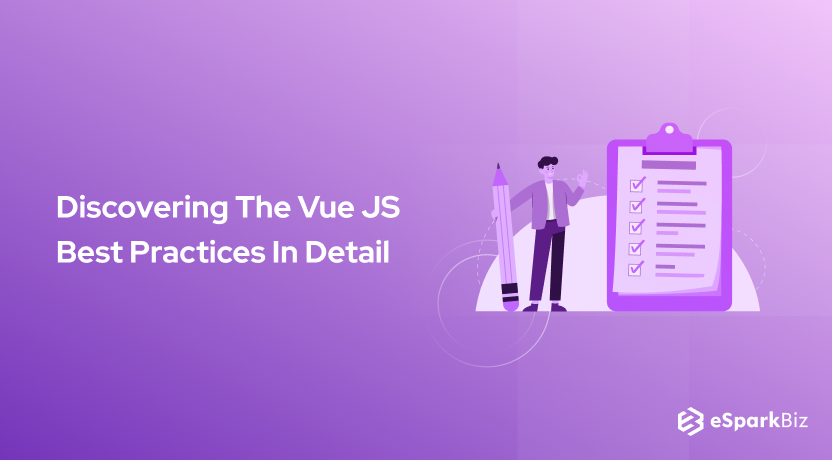Vue.js is an open-source progressive JavaScript framework for developing interactive interfaces we need to hire Vue js developers. You can easily develop a power-packed single-page application using the astonishing features of Vue.js. Today, we will talk about Vue JS Best Practices in detail.
The lightweight nature of this Amazing Vue JS Development Services will help you to integrate it into big projects for front-end development with no hassle.
What are the benefits of Vue.js?
- Great community support
- Huge library
- Hassle-free integration
- Super convenient to use
- Feature-rich
Let’s Analyze The Vuejs Best Practices
Data Initialization
Vue.js supports deterministic data models. This is what separates VueJS From AngularJS in the long run. It is highly recommended to maintain the smoother workflow of all the data properties.
For instance, see the given template:
<divid="demo">
<pv-class="green: validation.valid">{{message}}</p>
<inputv-model="message">
</div>
It performs an imperative role to initialize your data like this instead of an empty object:
new Vue({
el: '#demo',
data: {
message: '',
validation: {
valid: false
}
}
})
The data changes in Vue.js platform can be effectively observed by recursively moving the data object and converting the existing properties with Object.defineProperty.
If a property is unavailable during the creation of a code instance, Vue.js can’t be able to track it effectively.
With Vue.js, it is not compulsory to set every single nested property in your data. Additionally, it allows initializing a field as an empty object and integrating a new object with nested structures later if required.
The platform is fully capable to review the nested properties of the new object and monitor them effectively. So, always use Vuejs Best Practices.
Adding and Deleting Properties
Vue.js platform allows the data observation by converting the existing properties with Object.defineProperty.
But in ECMAScript 5, there is no fixed process to identify whether the new property is introduced or removed from an Object.
To overcome this constraint, observed Objects are integrated with three specific methods. The methods are:
- $add(key, value)
- $set(key, value)
- $delete(key)
These methods are truly helpful to add or remove properties from observed objects while doing DOM customization.
The prime difference between $add and $set method is that $add will return immediately if the key already exists on the object.
Remember, if you will change a data-bound Array directly by adding indices such as arr[1] = value), then Vue.js will be unable to detect the change.
In this case, you need to utilize augmented methods in order to notify Vue.js about those recent customizations. It’s one of the Vuejs Best Practices.
Observed Arrays can be augmented with two specific methods and the methods are:
- $set(index, value)
- $remove(index | value)
Vue.js component instances also have dedicated methods such as:
- $get(path)
- $set(path, value)
- $add(key, value)
- $delete(key, value)
vm.$get and vm.$set both accept paths. Even with the existence of these methods, it is always good to introduce only observed fields whenever required.
Understanding Async Updates
Vue.js performs the check updates non concurrently at whatever point a data change is observed. The platform will open a line and buffer all the information changes that occur in the same event loop.
In the event that a similar watcher is set off at different times, it will be driven into the line just a single time. Then, in the following event loop “tick”, Vue.js removes the queue and processes the fundamental
DOM updates only. Inside Vue.js utilizes MutationObserver if accessible for the offbeat queueing and falls back to setTimeout(fn, 0).
For instance, if you will set vm.someData = ‘new value’, then the DOM will update only in the next “tick”, not immediately when the queue is removed.
This situation sometimes becomes tricky when you want to customize something in the platform that is based on the updated DOM state.
Vuejs Best Practices allows developers to follow the “data-driven” approach and avoid direct focus on DOM.
When Vue.js is processing the up-gradation of DOM after the customization of data, you can use Vue.nextTick(callback) just after the data is changed.
When the callback is called, the DOM would have been updated. For instance:
<div id="example">{{msg}}</div>
var vm = new Vue({
el: '#example',
data: {
msg: '123'
}
})
vm.msg = 'new message' // change data
vm.$el.textContent === 'new message' // false
Vue.nextTick(function () {
vm.$el.textContent === 'new message' // true
})
You can also use the vm.$nextTick() instance method. This method is quite easier inside components. It does not require global Vue and its callback.
This context will be systematically bound to the latest Vue instance:
Vue.component('example', {
template: '<span>{{msg}}</span>',
data: function () {
return {
msg: 'not updated'
}
},
methods: {
updateMessage: function () {
this.msg = 'updated'
console.log(this.$el.textContent) // => 'not updated'
this.$nextTick(function () {
console.log(this.$el.textContent) // => 'updated'
})
}
}
})
Component Scope
Every component of the Vue.js has a specific Vue instance with its own extension. Being a developer you should closely understand how scopes work when using the different components.
If something shows up in the parent layout, it will be aggregated in parent scope; in the event that it shows up in child layout, it will be gathered in a child scope.
A typical slip-up is attempting to tie a directive to a child property technique in the parent format:
<div id="demo"> <!-- does NOT work --> <child-component v-on="click: childMethod"></child-component> </div>
If it is compulsory for you to bind child-scope directives on a component root node, you should do as such in the child component’s own layout:
Vue.component('child-component', {
// this does work, because we are in the right scope
template: '<div v-on="click: childMethod">Child</div>',
methods: {
childMethod: function () {
console.log('child method invoked!')
}
}
})
Note this example additionally applies to $index when utilizing a part with v-repeat
Likewise, HTML content inside a component container is considered “transclusion content”.
They won’t be embedded anyplace except if the child layout contains at least one <content></content> outlet. The embedded contents are likewise gathered in parent scope:
<div>
<child-component>
<!-- compiled in parent scope -->
<p>{{msg}}</p>
</child-component>
</div>
You can utilize the inline-layout attribute to show you need the substance to be incorporated in the child scope as the child’s layout:
<div>
<child-component inline-template>
<!-- compiled in child scope -->
<p>{{msg}}</p>
</child-component>
</div>
Communication between Instances
The most common pattern for parent-child correspondence in Vue.js platform is opting a parent method as a call-back to the child utilizing props. It’s one of the finest Vuejs Best Practices.
This permits the correspondence to be characterized inside the format (where composition occurs) while keeping the JavaScript usage details decoupled:
<div id="demo">
<p>Child says: {{msg}}</p>
<child-component send-message="{{onChildMsg}}"></child-component>
</div>
new Vue({
el: '#demo',
data: {
msg: ''
},
methods: {
onChildMsg: function(msg) {
this.msg = msg
return 'Got it!'
}
},
components: {
'child-component': {
props: [
{
name: 'send-message',
type: Function,
required: true
}
],
// props with hyphens are auto-camelized
template:
'<button v-on="click:onClick">Say Yeah!</button>' +
'<p>Parent responds: {{response}}</p>',
// component `data` option must be a function
data: function () {
return {
response: ''
}
},
methods: {
onClick: function () {
this.response = this.sendMessage('Yeah!')
}
}
}
}
})
At the point when you have to communicate over numerous nested components, you can utilize the Event System.
What’s more, it is likewise very practical to implement Flux-like engineering with Vue, which you might need to consider for large scope applications.
Use Data Property on Component
This can be considered as one of the most utilized Vuejs Best Practices. It allows you to use data property on a component as a capacity not only as a basic object.
At the point when the estimation of data is an object, it’s shared over all instances of a component.
data: {
title: ”
}
If you want to utilize the title property from better places of a component and someplace you have changed its estimation, it will be mirrored all the spots of the component.
Additionally, if you use an object and every instance of the component references a similar information object, changing the title from one bit will likewise change the title of every other place of the object.
data: function () {
return {
title: ”
}
}
Use Kebab-Case
If you are familiar with Vue.js functions, then you definitely know why you should consistently use kebab-case while composing any custom event. For example, building PWA with Vue JS can be easier with this kind of implementation.
The name of the event is dynamically changed to kebab-case internally even if you don’t provide the name of the event in kebab-case. Let’s see an example of data sharing between parent and child component:
Child:
<button v-on:click=“$emit(‘increase-count’, 1)”> Increment </button> Parent html: <counter … v-on:increase-count=“increaseCounter” ></counter>
Parent js:
methods: {
increaseCounter: function (count) {
this.value += count
}
}
Rule for Directive
The rule for directive says always use: key attribute with a v-for directive. This credit is utilized to check the uniqueness of every one of the rundown things. Vue’s virtual DOM makes VNodes on each of the things of a rundown.
So, if there is no key attribute in the rundown things, then Virtual DOM won’t distinguish every one of the things independently. When to Use Vue JS is such a critical decision to make.
So it will be hard for the virtual DOM to distinguish any progressions for a specific rundown thing.
<div v-for=“item in items” :key=“item.id”>
{{ item.value }}
</div>
Key Attribute Rule
Continuously utilizes an exceptional ID other than the list of the exhibit for the estimation of key characteristics. It’s one of the classic Vuejs Best Practices.
As you probably know exhibits are impermanent and the list of any items can be changed while including or eliminating the thing from the array.
<div v-for=“item in items” :key=“item.id”>
{{ item.value }}
</div>
Rule for V
You should follow the standard for V-. You should not utilize v-if with v-for as v-for has a higher need than v-if. See the accompanying model:
<ul>
<li
v-for=“car in cars”
v-if=“car.isActive”
:key=“car.id”
>
{{ car.model }}
</li>
</ul>
For this situation, the loop will be iterated over all the things in the rundown and afterward, it will check the v-if condition. So this is not a good approach.
Rather than this, you can register the rundown before delivering with the goal that solitary dynamic cars will be there to emphasize. It’s one of the Vue JS Best Practices.
<ul>
<li
v-for=“car in activeCars”
v-if=“car.isActive”
:key=“car.id”
>
{{ car.model }}
</li>
</ul>
computed: {
activeCars: function () {
return this.cars.filter(function (car) {
return car.isActive
})
}
}
Utilization of Multiple V-Condition
Never utilize multiple v-if conditions to deliver various sequential components. It is good to focus on using a <div> tag to wrap the components.
However, it will give an additional component that doesn’t have anything to do. So you can utilize the <template> tag to wrap the components.
<template v-if=“true”> <p>Paragraph 1</p> <p>Paragraph 2</p> <p>Paragraph 3</p> </template>
Use Key Property
Utilize key property if you want to utilize a reusable component to separate between them. Assume you need to utilize the same component for flipping.
If you utilize key property, then it will be blank, and this is the means by which Vue.js works. In the event that you permit users to flip between various login types:
<template v-if=“loginType === ‘username'”> <label>Username</label> <input placeholder=“Enter your username”> </template> <template v-else> <label>Email</label> <input placeholder=“Enter your email address”> </template>
At that point exchanging the login type in the code above won’t eradicate what the user has just entered. Since the two layouts use similar components, the <input> isn’t supplanted.
<template v-if=“loginType === ‘username'”> <label>Username</label> <input placeholder=“Enter your username” key=“username-input”> </template> <template v-else> <label>Email</label> <input placeholder=“Enter your email address” key=“email-input”> </template>
Now those sources of info will be delivered without any preparation each time you switch.
Detection Of Changes Within An Array
There are a few restrictions in Vue.js like Vue can’t recognize changes inside an array or object. This is an absolute necessity to follow Vue.js best practice.
At the point when you straightforwardly set a thing with the index, for example, vm.values[index] = newValue. There are three solutions to this:
- set(vm.values, index, newValue)
- values.splice(index, 1, newValue)
- $set(vm.values, index, newValue)
Object:
var vm = new Vue({
data: {
profile: {
firstName: “John”
}
}
})
Solution for adding a new property:
- set(vm.profile, ‘lastName’,”Doe”)
- $set(vm.profile, ‘lastName’,”Doe”)
Use of Shorthands
You can consistently use the potential of shorthands for directives. It implies that you have a great option of utilizing shorthands and the complete name of the directives.
Directive shorthands (: for v-tie:, @ for v-on: and # for v-slot) ought to be utilized consistently or never.
Use Vuex for State Management
If you are planning to build a powerful application, then you can consider this platform without a single bit of confusion. This is one of the most powerful Vue JS Best Practices.
Especially while having a data-heavy application and need to manage state across your application, use Vuex.
Code Splitting
Smoother and faster execution of an application is a major concern nowadays. In the case of a crucial project, you need to execute applications even in the stipulated timeline.
If possible, you should utilize code splitting. This is an extraordinary method of diminishing your primary java script pack size, and along these lines improves the underlying heap of your application.
const Loader = () => import(/* webpackChunkName: "aChunkName" */'../path/to/component.vue');
Component Registration
When working in components, you may need to import different components. You might have seen many times where components get registered in this way:
import MyAwesomeComponent from './my-awesome-component.vue';...
components: {
'my-awesome-component': MyAwesomeComponent
}
This isn’t off-base in any way, however there is a decent shorthand for doing this:
...
components: {
MyAwesomeComponent,
MyAwesomeComponentTwo,
MyAwesomeComponentThree
}
Validate Your Props
When passing props to a component, you should IMHO consistently do some approval. If you pass props without characterizing which type it should be (String, Array, Object… …), it tends to be extremely hard for other colleagues to realize what to pass.
Routing
When constructing a SPA application, you undoubtedly need customer side steering. Vue doesn’t send work in directing.
Vue is loaded with an authority module VueRouter that you can utilize. It’s quite easy to work with and gives everything the usefulness you require to make an incredible application.
So, always utilize these Vue JS Best Practices on a daily basis.
Form Validation
You must know, sometimes building form validation without any preparation can be challenging and obviously tedious.
Fortunately, there are a couple of incredible structure approval modules for Vue out there. Both are extraordinary and will save your valuable time and effort while working with forms.
Avoid Direct DOM Manipulation
A decent guideline when working with Vue, is that you should by all methods abstain from getting to the DOM legitimately. One of the fundamental purposes with a javascript system like Vue is to abstain from wrecking legitimately with the DOM.
This is one of the major differences between ReactJS and VueJS. So, take note of that.
Rather you should effectively use $refs. This is a spotless method of getting to the DOM and the Vue way. It’s additionally more viable, as you won’t need to deal depending on components with explicit class names, ids, and so on…
Looping
You can, without much of a stretch, loop through a variety of items with v-for
<div v-for="item in items" v-bind:key="item.id"> <!-- content --> </div>
Continuously make sure to include a key to your rundown except if you have an extremely straightforward array.
This is the suggested path as you can pick up execution at whatever point Vue needs to refresh a part in your loop, as it is utilized as an identifier. If you give duplicate keys, Vue will give you an admonition in the console.
Power of Mixins
At the point when you are building your applications, you may frequently need to reuse the code across components. Mixins are an incredible method to do this.
This implies that if you make a component that holds specific codes, lifecycle hooks, local state, and so on, you can make a mixin and cause others to expand this mixin.
Power of Filters
Filters are incredible, especially when you are managing date-organizing, monetary standards, dates & time, and so on.
Filters empower you to make worldwide or nearby organizing capacities that you can utilize.
filters: {
formatDate: function (date) {
if(date) {
//format using date-fns
return format(
new Date(date),
'DD.MM.YYYY'
)
} else {
return '--';
}
}
}
Cleaning up Memory
If you don’t provide the facility of eliminating custom events, instances, intervals, then at the end your application will turn out to be moderate and unresponsive.
Vue JS Best Practices allows you to add a feature that can effectively manage the use of memory. This could look something like:
created() {
refreshUserLoginTokenInterval(); //At created we start an interval to refresh
},
beforeDestroy () {
destroyUserLoginInterval(); //Before component is destroyed, we clean up
}
Conclusion
We have just shared a brief overview of Vue.js. The complete introduction of Vue.js can be a complete book within itself.
But now you can easily analyze the extraordinary features of this wonderful framework. Whether you are familiar with Vue.js or introduced the first time Vue JS Best Practices will help you in delivering thriving solutions. You can always consult with the adroit Vue JS Development Company to achieve Interactive interface for your software solutions.


-
What Vue.js Is Used For?
Vue.js open-source javascript framework that used to build modern web user-interfaces and single-page applications.
-
What Are Vue Components?
Vue Components are the most powerful feature of Vue.js that allows you to break the bigger application into smaller chunks.
-
Why Is Vue.js So Popular?
Vue.js is a highly flexible, lightweight, and modular framework. It allows you to build high-end UI for web applications with the utmost ease.
-
What Are Vue JS Best Practices?
The Vue JS Best Practices are listed as follows:
- Data Initialization
- Adding & Deleting Properties
- Understanding Async Update
- Communication Between Instances
- Data Property On Component
- Use Kebab-Case












